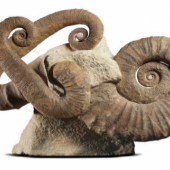Summers Place Auctions' 6th Evolution sale starts with a bang
-
Auktion20.11.2018
Recent Research at the McMaster University in Canada and the Max Planck Institute in Germany concluded that Life on Earth began after meteorites splashed into warm little ponds and leached them with essential elements between 3.7 and 4.5 billion years ago. They based this on exhaustive research and calculations drawing in aspects of astrophysics, geology, chemistry, biology and other disciplines. As a result this year's Evolution sale at Summers Place Autions on Tuesday, 20th November will be focusing on meteorites.
Often known as shooting or falling stars, due to the fireball that occurs when the meteoroid passes through the atmosphere and often accompanied by a sonic boom, a meteorite is a solid piece of debris that originates in outer space and survives its passage through the atmosphere to reach the surface of a planet or moon. They have played a big part in our history – the first iron had not been found in the earth and smelted but had in fact come out of this world. Meteorites were seen as precious, almost cult-like objects and considered of high value.
There are about 1400 known specimens in the world's collections, but meteorites have become attractive to researchers and collectors alike. They are strictly categorised and divided into three groups of stone, iron and stony-iron meteorites. Only 6% are iron meteorites and the Evolution auction will include four particularly fine examples.
A colossal Gibeon meteorite from the Namibian desert, which weighs an extraordinary 93kg (52 x 25 x 24 cm), carries an estimate of £40,000-60,000, whilst a slightly smaller meteorite piece from the same region (46 x 32 x 22 cm) and weighing 63kg ist estimated to fetch £30,000-50,000.
Two smaller meteorites from North Africa are also included in the auction and both classified as H5. The 26 cm high meteorite from the famous Tindouf (Algeria) strewn field is estimated at £2,000-3,000 and the smaller meteorite from Zuwairat (Mauritania) is 19 cm high and bidding will start at £800.
A very large Muonionalusta meteorite fragment from Northern Scandinavia is also included in the sale. This particularly large piece (23cm high by 40cm long by 26cm deep) had not been cleaned since its discovery and has been through four seperate Ice Ages since its fall to earth about one million years ago and as a result has a heavily weathered surface. It weighs 69.9 kg and is estimated at £25,000-40,000.
Meteorites are by far the oldest material available on the planet, but they are fairly vulnerable and water, salt and oxygen attack them and weather them, hence they change their surface and there are distinct differences between meteorites depending on where they have been found and under which conditions.
Meteorites may have started life on earth, but one of the leading theories of mass extinction, the demise of the dinosaurs, also concludes that it coincided with a large meteorite impact - the Cretaceous-Paleogene extinction event which occured 66 million years ago.
Meteorite falls also led to cultish worship. One of the Seven Wonders of the Ancient World, the Temple of Artemis at Ephesus, reportedly included a sacred, black stone enshrined in the temple, while the black stone set in the wall of the Kaaba has often been presumed to be a meteorite.
The oldest known iron artifacts – nine small beads hammered from meteoric iron – were found in northern Egypt and securely dated to 3200 BC, and were indeed made long before the Iron Age. Egyptian hieroglyphics even referred to iron as being 'from the sky' and Egyptian pharaoh Tutankhamun, who died in 1324 BC, was buried with an iron headrest, bracelet, and dagger from three different meteorites. Some Native Americans treated meteorites as ceremonial objects and the Indigenous peoples used iron-nickel meteorites as a source of iron metal.
One of the earliest known human finds of a meteorite in Europe seems to have been in the UK, where a stone meteorite was uncovered during an archaeological dig at Danebury Iron Age hillfort in the 1970s. The fact that it was found deposited part way down in an Iron Age pit (c. 1200 BC) suggests it must have been deliberately placed there. The largest single meteorite recorded ever to be found weighed 66-tons.
Scientific documentation only began in the last few centuries, but two of the oldest recorded meteorite falls in Europe were in Elbogen (1400) and Ensisheim (1492) and the German phycisist, Ernst Florens Chladni, was the first to published the idea that meteorites were rocks from space (1794), but it met with resistance from the European scientific community. Confucius, however, seems to have made the connection between the streak in the sky and the rock in the ground when he made the first description of a meteorite fall in 645 BC.
Other lots included in the auction are a rare and impressive Crinoid plaque which is 180cm high and an equally impressive Green River plaque; 'Darwin, the Tortoise', a Moa skeleton, a magnificent pair of whale jawbones, some fabulous Victorian bird taxidermy and a wide selection of minerals and fossils.
-
19.11.2021Es ist ein Bild, das jeder kennt und dass seinen Reiz trotz vielfacher Reproduktion nie verloren...
-
Das legendäre Kunstmuseum Waldviertel im Norden Österreichs lädt Sie zu einer Entdeckungsreise in...
-
20.11.2018Auktion »
018 Sales: 20th November – Evolution Auction 2019 Sales: 12th & 13th March
June, September and November











